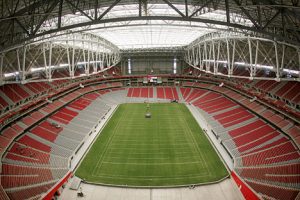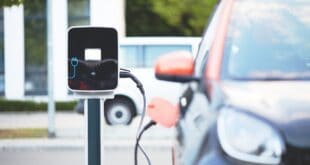U.S. Stadiums Go Solar: Major Pro Sports Leagues Move Together Toward Renewable Energy
MLB, MLS, NBA, NFL, NHL all call for teams to encourage solar power to help combat climate change
 CHICAGO (September 8, 2010) — The nation’s major professional sports leagues are collectively sending an important cultural message in the battle against climate change by encouraging and endorsing the use of solar power and clean energy in arenas and stadiums throughout the United States.
CHICAGO (September 8, 2010) — The nation’s major professional sports leagues are collectively sending an important cultural message in the battle against climate change by encouraging and endorsing the use of solar power and clean energy in arenas and stadiums throughout the United States.
Major League Baseball, the National Football League, the National Basketball Association, the National Hockey League, and Major League Soccer delivered a letter encouraging their teams and facilities to begin using solar power as they continue the effort to green North America’s professional sports. The leagues also distributed a comprehensive solar development guide produced on their behalf by the Natural Resources Defense Council (NRDC) and Bonneville Environmental Foundation (BEF) outlining the work necessary for each stadium to add on-site solar power generation to its energy mix. Having all professional leagues engaged collectively in this manner is an extraordinary event, pointing to the growing cultural transcendence of the fight against climate change.
“Our sport was born outdoors, in winter weather, and many of our players began skating on frozen lakes and ponds,” said Gary Bettman, Commissioner of the National Hockey League.”We are acutely aware that our League, as well as all sports leagues, need to be responsible stewards of our planet. Utilizing solar energy is an important and efficient environmental action that sends a broader signal to the culture. It not only conveys a critical message to all sports fans, it improves the efficiency of our facilities and protects the environment.”
The embrace of solar power sends a strong message to millions of fans and event-goers throughout the country—and it could have a big impact on the teams’ bottom lines too. In most American cities, solar panels can pay for themselves, potentially offsetting significant energy costs in the long-term. Los Angeles’ STAPLES Center, for example, currently addresses 5% of the facility’s total energy needs with a solar array.
“The distribution of solar power development guides by all professional sports leagues reflects a real cultural shift in our thinking about energy that is taking place throughout the business community and the nation at large,” said NRDC Senior Scientist Allen Hershkowitz, PhD. “Throughout US history professional sports leagues have stepped up on behalf of our troops. They have stepped up for civil rights. And now they are stepping up for the environment. It’s not about politics; it’s about what is right for America. This is really a remarkable moment and effort coming from our professional sports leagues. The private sector does not have to wait for government action in order for them to address the urgent issue of climate change.”
The solar development guide co-authored by NRDC and BEF leverages the examples set by the STAPLES Center in Los Angeles and US Airways Center data in Phoenix, two leading arenas already taking advantage of solar panels. If all arenas and stadiums had solar installation equal to the STAPLES Center, they would:
Reduce carbon emissions by approximately 86.6 million lbs/yr, comparable to taking 8,340 cars off the road
Create enough electricity to power roughly 4,812 American homes for a year
Save the equivalent of 33,970 barrels of crude oil per year.
The benefits of solar are not limited to hot and dry geographies such as Southern California and the Southwestern U.S. The Boston Red Sox have installed 28 solar panels at Fenway Park which currently generate 37% of the electricity used to heat water in the park. The stadium, built in 1912, is a great example of how solar power can augment any facility regardless of age or climate. Panels are also being used in Pittsburgh, Seattle, and Cleveland.
“You expect solar on the Staples Center, but maybe not in Seattle,” said Darryl Benge, Assistant General Manager of Qwest Field and Event Center (home to the Seattle Seahawks). “But despite our town’s reputation for rainy weather, we are excited to generate some of our own electricity and show that renewable energy can work everywhere. We used the information provided by NRDC and BEF to evaluate our sites and build an RFP for the system we will be putting on our event center roof.
The NRDC and BEF document is intended as a resource for teams and facility operators across the country to help teams embrace the leagues’ direction. It offers a step-by-step outline on how to begin moving forward with on-site solar panels, including an overview of the advantages and challenges that come with various technologies, ideas on locating panels and their dimensions, cost estimates and suggestions on financing the initial installation costs, as well location-specific estimates on output (time for the energy generated to payback initial costs) and CO2 savings for each pro team market.
The league letters and development guide are available online at
http://www.nrdc.org/greenbusiness/guides/sports/solarguide.asp
“This guide is essentially a playbook for stadium owners interested in building on-site solar energy production,” said Margie Gardner, CEO of the Bonneville Environmental Foundation.
 Alternative Energy HQ solar power for homes, wind energy, and bio fuel issues
Alternative Energy HQ solar power for homes, wind energy, and bio fuel issues





